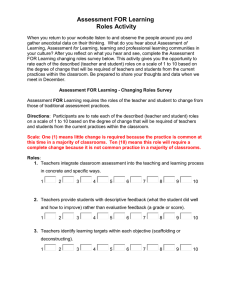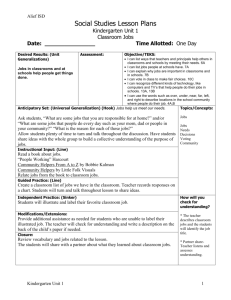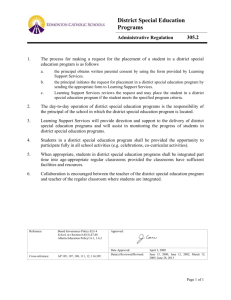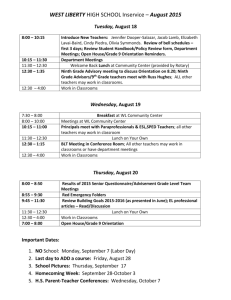in A.
advertisement
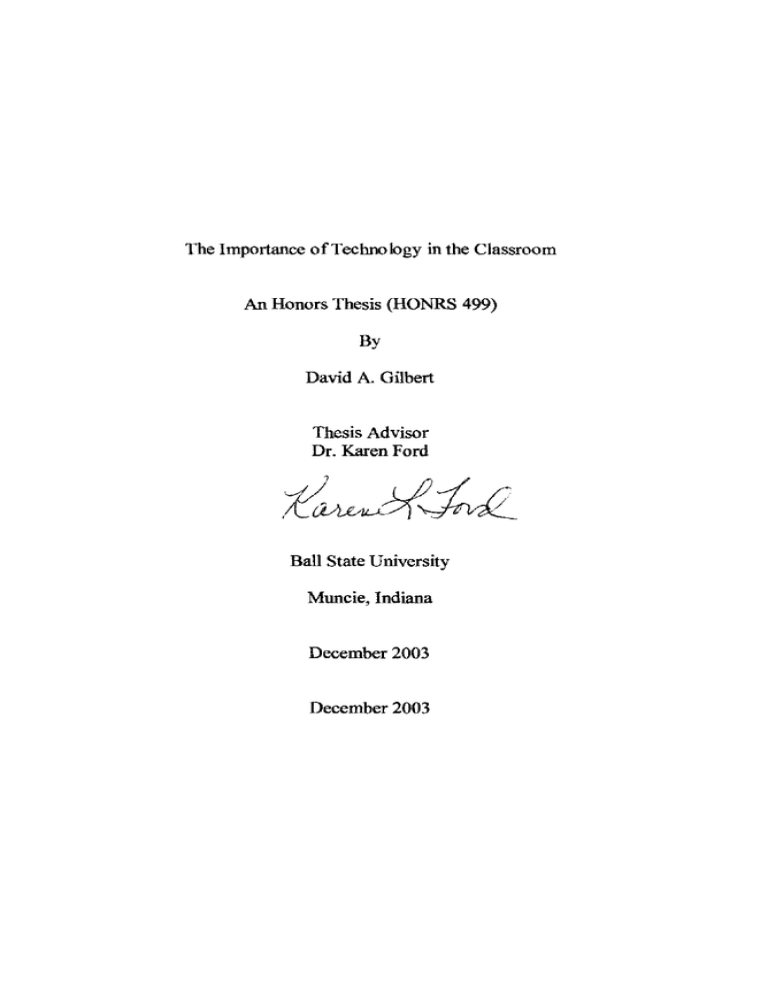
The Importance of Techno logy in the Classroom An Honors Thesis (HONRS 499) By David A. Gilbert Thesis Advisor Dr. Karen Ford Ball State University Muncie, Indiana December 2003 December 2003 Abstract This project examines the role of technology in the classroom and its benefits. The first part is a research paper on the use of technology in classrooms today. It includes why many teachers are hesitant to use technology in their classrooms, some benefits to using technology in the classroom, and some ways to integrate technology into the classroom. The second part is a disk that contains things that I created using technology that will enhance the learning environment of a history classroom. I believe it is important to use technology in the classroom and have included some things that teachers can use. Included are a Simulated Flash Index (SFI) that can be used for introducing a unit or lesson, a Jeopardy review game template, and important web sites for U.S. History teachers to use. The paper and the created projects work together to demonstrate the ease and importance of using technology in the classroom. Acknowledgements Many thanks are due to Dr. Karen Ford, my thesis advisor, for her role in this rigorous process. She challenged me to undertake this topic in the first place, offered valuable comments and feedback throughout the process, and provided superior advice when I was technologically challenged. Thank you Dr. Ford for your patience and willingness to help me throughout this endeavor. I would also like to thank Dr. Dean Cantu for inspiring the creative project part of this thesis and for teaching me how to use technology beneficially in the classroom. The world we live in today is constantly changing and resembles very little the world that our parents and grandparents grew up in. Advances in technology have improved nearly every aspect of our lives and makes many things much easier today than they were twenty or thirty years ago. Nearly every professional field has benefited from these technological advances and uses these advances to better their professions. The medical and science fields have benefited from advances in machines and teclmiques that make our lives safer and easier, and they continue to adapt to these changes. It would be unheard offor a doctor to refuse to use new advances in technology just because he or she does not want to change the way he or she has done it for years. That doctor would be out of a job very soon, unless he or she adapted. However, there is one profession that does not seem eager to apply technological advances to its field. That is the profession that is shaping the lives of our future leaders of this country, the teaching profession. Many teachers continue to teach their classes the same way they have for ten or twenty years and have not brought any technology into the classroom. They continue to lecture and make students read outdated textbooks, and students continue to be bored and unmotivated to learn. In filet, some teachers never even change their lesson plans to adjust from year to year. Why is the teaching profession the only profession that does not expect its teachers to incorporate technology into their c1assrooms? If technological advances have been so beneficial in so many other professions, why do so many teachers continue living in the "Stone Age" and unwilling to change their ways? There are several benefits to using technology in the classroom, and it is imperative that teachers begin to incorporate the use of technology into their classrooms. It will benefit everyone involved and will enhance the learning environment. The integration oftechnology into classrooms is not a new concept. It was a major focal point of the Clinton administration's education plans. The Clinton administration really strove to improve funding fur schools, so that they could purchase computers and other technology related materials for their classrooms. By 1999, there was one computer for every six children (Bennett, 2002), and by the full of2000, 98 percent of public schools in the United States had access to the Internet (Reading Today, 2001). Yet despite this massive infusion of technology, overall improvements in education have been minimal (Bennett, 2003). This is because it is not enough to just place computers in the classroom. Teachers need to know how to use them and how to make the use of computers beneficial to their students. This is where it becomes difficult for advocates of technology's use in the classroom. Technology is not a great benefit if teachers do not know how to use it or do not know how to properly use it. This is part of the reason why overall improvements have been minimal since the integration of so many computers into classrooms today. Just because there is a greater number of computers in schools today, does not mean that they are being used by teachers to help their students. This influx of computers and other technological materials into classrooms does not mean much until teachers begin to use them on a regular basis. Teachers are the ones in control of their classrooms, and generally, technology will not be used in a classroom unless that teacher initiates it. There are so many more things that can be done in the classroom to enhance the learning enviromnent of students through the use of technology, but it begins with the teacher. Then, why are so many teachers hesitant to use technology in their classrooms? Bernard Percy (2003) gives two major reasons why teachers have been slow to adopt the use of technology in their classrooms. First of all, they are not convinced it will be helpful in meeting their pressing needs. They firmly believe that it will be more of headache and problem to learn and use than it is worth. Second, educators too often do not have the sense of urgency, personal demand and willingness to confront the difficulties they may face in learning to use and implement the technology properly. They do not believe it can really help them achieve their goals more efficiently, effectively and easily once it has been properly utilized. Teachers that have been doing it for awhile are often unwilling to change, because they do not know how to use this new technology and are often scared to learn. I experienced this while I was student teaching. The teacher I worked with said that he knew there was so mnch more he could be doing in his classroom by using technology, but he just did not know how to use it and was scared to learn. He did not want to try using something that his students probably knew more about and could use better than he could, so he did not try to learn about any of this technology. So, it is easy to see, and somewhat WJderstandable, why veteran teachers are so apprehensive to use technology in the classroom, but what about young teachers just out of college? Why have many of them not embraced the use of technology in their classrooms? It is often because there is not enough coursework in this area for students in the teaching field. Current required course work that is designed to meet state and national accreditation standards might not be supplying future teachers with the background or confidence to utilize those skills effectively in their classrooms for instructional purposes (Bennett, 2003). There are not being adequately prepared to use technology. I know this is the case in my situation. I was never required to take any courses on how to use technology in the classroom. The only time I was encouraged to use technology and shown how to use technology was in my EDRDG class and my social studies methods class, and this was only because the professors I had for these classes believed in it. The use of technology needs to be integrated into the curriculum for education majors, especially during the student teaching phase, when students are actually in the classroom. Student teachers may need more opportunities to apply instructional technology during prior practicum field experiences as well as during their final internship. This is an area that could be assisted through distance learning, incorporating email mentoring and support systems by linking qualified supervisors and master teachers together electronically (Bennett, 2003). Universities need to adjust their curriculum to give students adequate preparation to use technology in their classrooms. Change is continuous and the coursework for training teachers must continue to change in response to the skills needed in the societal work place as well as in the development of standards and curricula that is implemented for teacher certification programs (Bennett, 2003). Technology, when used properly by teachers, enhances the learning environment for students in the classroom. Even the National Board for Professional Teaching Standards has begun to realize this and focus more on it in its standards. The board, which has generally been conservative about the value of technology in teaching, recently completed an ouline library of models for how to use technology in the classroom (Trotter,2003). Teachers now have access to lesson plans, supplemental materials, ouline field trips, WebQuests and ThinkQuests, and animated processes via the Internet. Students can become more engaged in the learning process through the use of technology. Technology-in the form of e-mail, online conrerencing, Web databases, graphic organizers, and presentation medium-facilitates and supports the engagement process (Goddard, 2002). Teachers can not only use the Internet to engage their students and gather materials, but they can also use technology to present a lecture. PowerPoint presentations allow teachers to insert pictures, audio, maps, charts and graphs, etc. that engage students beyond just a lecture off of an overhead outline. Teachers that adapt to technological changes in the classroom also set an example to their students who will have to deal with changes in their lives (Goddard, 2002). If teachers are not willing to change and adjust to the times, how are students going to prepare for changes they will certainly face in their lives? Change may be icky, but educators who capitalize on the relationship between technology and education reform can help students develop higherorder thinking skills and function effectively in a world beyond the classroom (Goddard, 2002). On-line materials and other uses of technology challenge students more than just reading the textbook. Students are actively engaged in the learning process and, thus, must think at a higher level. Using technology can also develop the social skill of students, because often times students need to work in groups on computers because there are not enough computers for each individual student. Students can also work in groups to solve problems using WebQuests or ThinkQuests. Technology is very beneficial to the engagement and learning process of students in the classroom Technology is a major asset that teachers should use in their classrooms, especially in my teaching area of social studies. For my Honors Thesis Project, I put into action the use oftechnology that can enhance the learning enviromnent. I created a Simulated Flash Index (SFI) that I and other teachers can use to introduce a unit on Indiana history. An SF! takes pictures, maps, etc. that relate to a topic and places them in a PowerPoint presentation that is accompanied by music that also relates to the topic. For Indiana history, I placed pictures of famous Hoosiers, pictures from Indiana history, and pictures that just relate to Indiana in general into a PowerPoint presentation. Then, I put John Cougar Mellencamp's song "Small Town" into the presentation to go along with the timed slides. The song plays throughout the presentation as each slide changes after three seconds. This can be done to introduce any topic or unit. An SF! is a good way to pique student interest on a topic and is a good way for teachers to introduce a lesson to their students. I also created a Jeopardy game that can be used to playa review game with students after a unit or chapter has been finished. I created this specific Jeopardy game to review a unit on the Civil War, but adjustments can be made to change the categories and the questions for different subjects. The game is in the form of a PowerPoint presentation and can be easily projected on the overhead screen for the entire class to see. It is also a fun way for the students to review and it even has the Jeopardy theme song on it. I also searched the Internet and fuund what I considered to be the best web sites for United States history. Teachers can use these websites to get lesson plan ideas, primary documents, and other vital information. I also included these on a PowerPoint presentation. Technology benefIts teachers and students alike, and it is my hope that teachers begin to use technology more frequently in the classroom. Bibliography Bennett, D. (2002). The future of computer technology in k-12 education. Phi Delta Kappan, 83 (8), 621-625. Goddard, M. (2002). What do we do with these computers? Reflections on technology in the classroom. Journal ofResearch on Technology in Education, 35 (1), 19-27. Percy, B. (2003). Grabbing technology by the tail. THE Journal, 31 (1),48. Fact and fiction. (2001). Reading Today, 19 (2),10. Trotter, A (2003, October 15). National teaching board elevates technology's profile. Education Week 23, 8.

